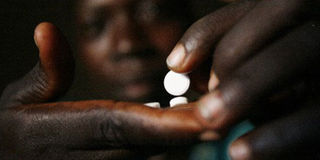Blow to Aids patients as donor funds shrink

The cost of treating nearly 940,000 Kenyans currently enrolled in the antiretroviral programme is Sh18.4 billion. FILE PHOTO
What you need to know:
- The decrease — the first in five years — from $8.6 billion to $7.5 billion is bound to hurt plans to reach more patients with life-saving medicine.
- This cost is expected to double by 2018/19 following the launch of the new HIV guidelines that aim at starting treatment for all patients who test positive for HIV, according to Health Cabinet Secretary Cleopa Mailu.
Donor funding for Aids drugs in low-income and low middle-income countries such as Kenya has shrunk by more than Sh100 billion, putting the lives of millions of patients at risk.
The decrease — the first in five years — from $8.6 billion to $7.5 billion is bound to hurt plans to reach more patients with life-saving medicine, according to a new health report.
Kenya has about 1.5 million such patients.
The report, Financing the Response to HIV in Low and Middle Income Countries, attributes the drop to many “competing funding demands, including humanitarian emergencies and the refugee crisis”.
It also attributes the decline to the appreciation of the US dollar, which has affected major currencies in most donor countries.
TREATMENT COSTS TO DOUBLE
Some donor countries, led by the US, have also failed to release funds, according to the report compiled by the Kaiser Family Foundation and the Joint United Nations Programme on HIV/Aids and was released on Sunday at the 21st World Aids Conference in Durban, South Africa.
The cost of treating nearly 940,000 Kenyans currently enrolled in the antiretroviral programme is Sh18.4 billion — nearly 30 per cent of the Ministry of Health's budget.
The government contributes only Sh900 million annually.
This cost is expected to double by 2018/19 following the launch of the new HIV guidelines that aim at starting treatment for all patients who test positive for HIV, according to Health Cabinet Secretary Cleopa Mailu.
Peter Kinuthia, the programme officer for HIV investments at the National Aids Control Council (NACC), called on the government to increase domestic funding to save more lives.
The council estimates that new infections among people aged 15 to 24 stands at 35,776, up from 29,352 in 2014.
“Kenya needs to increase financing and show commitment in HIV response by increasing her contribution from domestic sources,” he said.
SETBACKS EXPECTED
Nduku Kilonzo, the executive director of the NACC, said: “If this trend continues, Kenya could experience setbacks in the war against HIV. Kenya is concerned that some donor countries have reversed their commitments.”
Nelson Otwoma, the national coordinator of the Network of People Living with HIV, described the decline in funding as “a bitter pill to swallow”.
Kenya is expected to procure its antiretroviral drugs and related commodities at market prices and not at a subsidised rate due to the Trade Related and Intellectual Property Rights agreements.
Donors are also increasingly targeting specific vulnerable groups or key populations, including homosexuals.
Dr Mailu suggested establishing an HIV fund to supplement exchequer resources.






